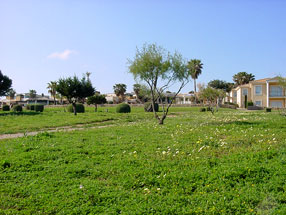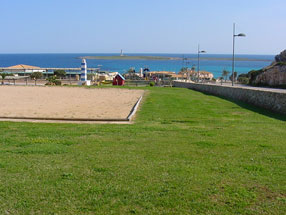Recycled water
Aigües Sant Lluís, S.L., is part as co-owner and manager of the treated water user community from (E.D.A.R.), Estación Depuradora de aguas residuales of Sant Lluís for the use of irrigation for public and private gardens, as well as drainage.
This community is formed by Sant Lluis Town Hall, Group of Companies Alonso Marí, S.A., Bada Badoc, La Era Grande S.L., Protume S.L., and Aigües Sant Lluís S.L.
The Community receives the concession from the General Direction of Water resources, organisation which depends on the Environment Conselleria of the Balearic Government on April 4th 2001, giving it a maximum of 200.000 m3 annual of treated water for public areas irrigation, private gardens and septic tanks in resort hotels.
Objectives of the Community:
- Gradually increasing the water network in order to give the service to larger consumers.
- Increasing consumption in order to lower the cost and the final price, making more attractive and profitable to recycle the water.
- Making a sustainable water management by extending its use, we could have an ecological benefit, because drinkable water produced would be replaced by recycled water quality.
Data service:
Nowadays our service is composed by a pumping station which collects the treated water of E.D.A.R. of Sant Lluís and be sent to a tank of 800 m3 capacity. Thanks to the 7.600 m of pipes, water is distributed in different parts of the residential areas of Punta Prima and Biniancolla, T.M. of Sant Lluís, (Minorca).
Graphs:
We present a first evolutionary graph about the total annual consumption of the customers of the community, the second one is to compare with the drinkable and recycled water and the third one with the percentage of total consumption of both supplies.
General consumption.Community recycled consumption.
| General consumption.Community recycled consumption. | |
| Year | Total consumption in cubic meters |
| 2000 | 50060 |
| 2001 | 51711 |
| 2002 | 58042 |
| 2003 | 68889 |
| 2004 | 83649 |
| 2005 | 93508 |
| 2006 | 83009 |
| 2007 | 79241 |
| 2008 | 76143 |
| 2009 | 67458 |
| 2010 | 74728 |
| 2011 | 70826 |
| 2012 | 72733 |
| 2013 | 57383 |
| 2014 | 59611 |
| 2015 | 60378 |
| 2016 | 62545 |
| 2017 | 56696 |
| 2018 | 45292 |
| 2019 | 47297 |
| 2020 | 32276 |
| 2021 | 42675 |
| 2022 | 54162 |
| 2023 | 51514 |
Comparisons between drinking water and recycled water
| Comparisons between drinking water and recycled water | ||
| Year | Drinking water consumption- Recycled water | |
| 2000 | 101627
50060 |
Total consumption 151687 |
| 2001 | 134775
51711 |
Total consumption 186486 |
| 2002 | 123790
58042 |
Total consumption 181832 |
| 2003 | 110004
68889 |
Total consumption 178893 |
| 2004 | 104118
83649 |
Total consumption 187767 |
| 2005 | 92453
93508 |
Total consumption 185961 |
| 2006 | 116342
83009 |
Total consumption 199351 |
| 2007 | 92521
79241 |
Total consumption 171762 |
| 2008 | 97654
76143 |
Total consumption 173797 |
| 2009 | 83263
67458 |
Total consumption 150721 |
| 2010 | 80114
74728 |
Total consumption 154842 |
| 2011 | 84292
70826 |
Total consumption 155118 |
| 2012 | 82533
72733 |
Total consumption 155266 |
| 2013 | 89602
57383 |
Total consumption 146985 |
| 2014 | 95099
59611 |
Total consumption 154710 |
| 2015 | 78921
60378 |
Total consumption 139299 |
| 2016 | 100846
62545 |
Total consumption 163391 |
| 2017 | 99852
56696 |
Total consumption 156548 |
| 2018 | 99292
45292 |
Total consumption 144584 |
| 2019 | 103318
47297 |
Total consumption 150615 |
| 2020 | 43432
32276 |
Total consumption 75708 |
| 2021 | 87120
42675 |
Total consumption 129795 |
| 2022 | 122350
54162 |
Total consumption 176512 |
| 2023 | 121242
51514 |
Total consumption 172756 |
% Drinking water - Recycled water
| Comparisons between drinking water and recycled water | |
| Year | Drinking water consumption- Recycled water |
| 2000 | 67.00
33.00 |
| 2001 | 72.27
27.73 |
| 2002 | 68.08
31.92 |
| 2003 | 61.49
38.51 |
| 2004 | 55.45
44.55 |
| 2005 | 49.72
50.28 |
| 2006 | 58.36
41.64 |
| 2007 | 53.87
46.13 |
| 2008 | 56.19
43.81 |
| 2009 | 55.24
44.76 |
| 2010 | 51.74
48.26 |
| 2011 | 54.34
45.66 |
| 2012 | 53.16
46.84 |
| 2013 | 60.96
39.04 |
| 2014 | 61.47
38.53 |
| 2015 | 56.66
43.34 |
| 2016 | 61.72
38.28 |
| 2017 | 63.78
36.22 |
| 2018 | 68.67
31.33 |
| 2019 | 68.60
31.40 |
| 2020 | 57.37
42.63 |
| 2021 | 67.12
32.88 |
| 2022 | 69.32
30.68 |
| 2023 | 70.18
29.82 |



 Customer access
Customer access